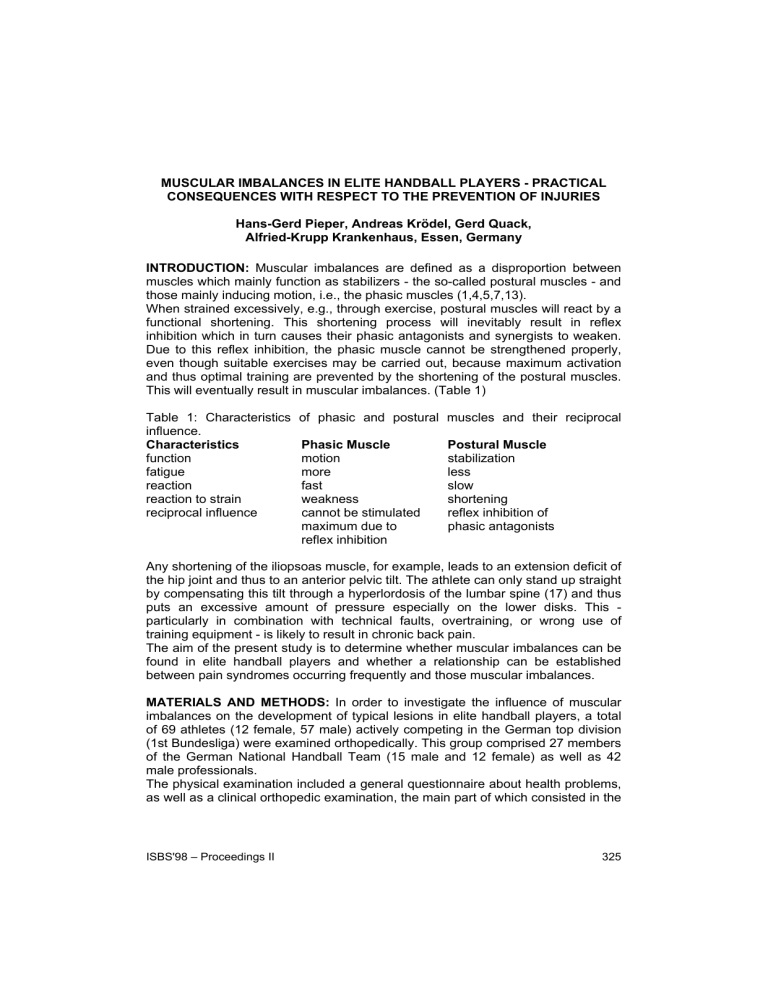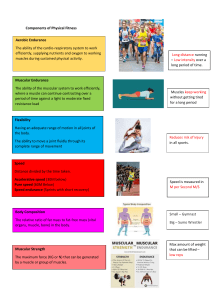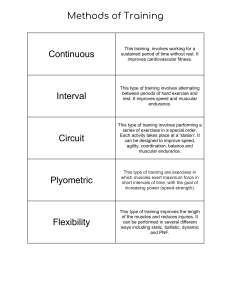
MUSCULAR IMBALANCES IN ELITE HANDBALL PLAYERS - PRACTICAL CONSEQUENCES WITH RESPECT TO THE PREVENTION OF INJURIES Hans-Gerd Pieper, Andreas Krödel, Gerd Quack, Alfried-Krupp Krankenhaus, Essen, Germany INTRODUCTION: Muscular imbalances are defined as a disproportion between muscles which mainly function as stabilizers - the so-called postural muscles - and those mainly inducing motion, i.e., the phasic muscles (1,4,5,7,13). When strained excessively, e.g., through exercise, postural muscles will react by a functional shortening. This shortening process will inevitably result in reflex inhibition which in turn causes their phasic antagonists and synergists to weaken. Due to this reflex inhibition, the phasic muscle cannot be strengthened properly, even though suitable exercises may be carried out, because maximum activation and thus optimal training are prevented by the shortening of the postural muscles. This will eventually result in muscular imbalances. (Table 1) Table 1: Characteristics influence. Characteristics function fatigue reaction reaction to strain reciprocal influence of phasic and postural muscles and their reciprocal Phasic Muscle motion more fast weakness cannot be stimulated maximum due to reflex inhibition Postural Muscle stabilization less slow shortening reflex inhibition of phasic antagonists Any shortening of the iliopsoas muscle, for example, leads to an extension deficit of the hip joint and thus to an anterior pelvic tilt. The athlete can only stand up straight by compensating this tilt through a hyperlordosis of the lumbar spine (17) and thus puts an excessive amount of pressure especially on the lower disks. This particularly in combination with technical faults, overtraining, or wrong use of training equipment - is likely to result in chronic back pain. The aim of the present study is to determine whether muscular imbalances can be found in elite handball players and whether a relationship can be established between pain syndromes occurring frequently and those muscular imbalances. MATERIALS AND METHODS: In order to investigate the influence of muscular imbalances on the development of typical lesions in elite handball players, a total of 69 athletes (12 female, 57 male) actively competing in the German top division (1st Bundesliga) were examined orthopedically. This group comprised 27 members of the German National Handball Team (15 male and 12 female) as well as 42 male professionals. The physical examination included a general questionnaire about health problems, as well as a clinical orthopedic examination, the main part of which consisted in the ISBS'98 – Proceedings II 325 application of the "Functional Muscular Diagnostics" (2,9,10,11,13,15) as first described by JANDA (4). RESULTS AND DISCUSSION: The results reported here systematically apply only to the group of male subjects, because of the limited number of female athletes involved in this study. The results from this latter group will, however, be considered in the discussion. 37% of the male athletes reported chronic back problems, and 32% suffered from recurrent shoulder pain. The clinical examination revealed frequent incidences of muscular shortening and weakness, mainly occurring in the pelvic region, as well as the shoulder (Tables 2 and 3). Table 2: Frequency of muscular shortening in 69 elite handball players. Muscle males (n = 57) females (n = 12) hamstrings 84.2 % 66.6 % major pectorals 77.2 % 41.7 % adductors 71.9 % 91.7 % rectus femoris 71.9 % 91.7 % iliopsoas 59.6 % 41.7 % trapezius (desc.) 54.4 % 75.0 % gastrocnemius 52.6 % 58.3 % lumbar quadratus 47.4 % 33.3 % Table 3: Frequency of muscular weakness in 69 elite handball players. Muscle males (n = 57) females (n = 12) abdominal muscles 77.2 % 83.3 % rhomboids 68.4 % 83.3 % gluteal muscles 40.4 % 91.7 % serratus anterior 24.6 % 25.0 % erector spinae lumb. 22.8 % 33.3 % As far as back pain is concerned, handball players exhibiting clinical symptoms also tend to have more muscular imbalances in the low back - pelvis - hip region as compared to those not suffering from lumbar problems (Table 4). The typical distribution of muscular shortening (especially of the hamstrings and the iliopsoas) and muscular weakness (abdominal and gluteal muscles, erector spinae lumbalis) can adversely affect the statics of the pelvic region. The resulting hyperlordosis will be increased by certain training techniques, i.e., the throwing of medicine balls, which can lead to a segmental instability of the lumbar spine, thus contributing to chronic back pain. Table 4: Muscular shortening in male handball players = 36) back pain. Muscle with back pain hamstrings 90.5 % rectus femoris 81.0 % lumbar quadratus 71.4 % iliopsoas 61.9 % with (n = 21) and without (n without back pain 80.6 % 69.4 % 44.4 % 55.6 % Those handball players suffering from shoulder pain show markedly more muscular imbalances of the shoulder girdle as compared to those who did not report any 326 ISBS'98 –Proceedings II problems (Table 5). These imbalances might cause faulty throwing technique, because due to muscular shortness of the major pectoral the amount of scapular adduction and depression is decreased. The shoulder thus being kept in constant protraction, the anterior joint capsule and the rotator cuff are subjected to pathological strain in every throwing motion of the arm, thus causing gleno-humeral instability and secondary impingement syndrome of the rotator cuff (8). Table 5: Muscular shortening in male handball players with (n = 18) and without (n = 39) shoulder pain. Muscle with shoulder pain without shoulder pain major pectoral 94.4 % 76.9 % trapezius (desc.) 61.1 % 38.5 % triceps brachii 38.9 % 25.6 % Muscular imbalances are to be observed in other athletic disciplines as well. The distribution of parts of the body affected, as well as the frequency of occurrence vary depending on the discipline (Tables 6 and 7). In skiing, for example, no muscular shortening of the gastrocnemius and the adductors is to be found due to constant use of skiing boots forcing the ankle joint into extension and thus stretching the muscles (13). In swimmers, on the other hand, the frequency of pectoral shortening is much lower than that in handball players, probably due to better and more frequently performed exercises (12). Table 6: Muscular shortening in different athletic disciplines (12, 14). Muscle Swimming (n = 54) Skiing (n = 8) hamstrings 94 % 31 % major pectorals 13 % adductors 24 % 0% rectus femoris 96 % 81 % iliopsoas 98 % 81 % gastrocnemius 78 % 0% Table 7: Muscular weakness in different athletic disciplines (12, 14). Muscle Swimming (n = 54) Skiing (n = 8) abdominal muscles 85 % 75 % erector spinae lumb. 72 % vastus medialis 50 % gluteal muscles 28 % 63 % Among our subjects, the frequency of muscular shortening and weakness differed somewhat between men and women in the sense that the latter group showed a higher frequency of shortening of the adductors, rectus femoris, and trapezius accompanied by weaker rhomboids and gluteal muscles than the male group. On the other hand, they exhibit fewer shortenings of major pectorals, iliopsoas, hamstrings, and lumbar quadratus as compared to male players. There is no immediate explanation for this finding. Possibly, the group of female athletes is too small to be representative, but differences in training practices between male and female teams are definitely also a possibility. ISBS'98 – Proceedings II 327 CONCLUSION: The type and frequency of muscular imbalances found in handball players as compared to those in other athletic disciplines clearly shows an interrelation between those imbalances and the occurrence of injuries or chronic health problems. This conclusion is supported by the observation that in the team of TuSEM Essen there was a marked increase in training injuries in the 1990/91 season as compared to 1989/90 after systematic stretching and strengthening had been discontinued. Thus in addition to other factors - technical faults, overtraining, wrong use of training equipment - they may constitute a major cause for typical sport-specific lesions in elite handball players. The way to prevent this type of injury would be to include suitable stretching and strength exercises in the training program for handball players (3,7,14,15,16). Special exercises for this purpose have been described (6). REFERENCES: Berthold, F., Jelinek, W., Albrecht, R. (1981). Die Bedeutung der Muskelfunktionstests nach Janda für die sportärztliche Praxis. Med. u. Sport 21, 171-174. Daniels, L., Worthingham, C. (1985). Muskelfunktionsprüfung - Manuelle Untersuchungstechniken. 5. ed. Stuttgart: G. Fischer-Verlag. Dietrich, L., Berthold, F., Brenke, H. (1985). Muskeldehnung aus sportmethodischer Sicht. Med. u. Sport 25, 52-57. Janda, V. (1986). Muskelfunktionsdiagnostik. 2. ed. Berlin: Verlag für Volk und Gesundheit. Kendall, H. O., Kendall, F. P. (1949). Muscles - Testing and Function. Baltimore: Williams & Williams. Ludwig, T., Pieper, H.-G., Pühler, B. (1992). Muskuläre Ungleichgewichte bei Handballspielern. Handballtraining 14, 19-28. Pieper, H.-G. (1987). Prophylaxe muskulärer Verletzungen im Triathlon. In D. Bremer, M. Engelhardt, A. Kremer, R. Wodick (Eds.), Triathlon: Sportmedizin und Trainingswissenschaft 1. Ahrensburg: Czwalina-Verlagsburg. Pieper, H.-G., Quack, G., Krahl, H. (1993). Impingement of the Rotator Cuff in Athletes Caused Instability of the Shoulder Joint. Knee Surg. Sports Traumatol. Arthroscopy 1, 9799. Riepenhausen, U., Lachmann, D. (1984). Zum Einsatz der JANDA- Tests für die Objektivierung muskulärer Dysbalancen und deren Beseitigung durch Bewegungstherapie in der Sportmedizin. Z. Physiotherapie 36, 53-57. Schmid, H., Spring, H. (1983). Muscular Imbalance in Skiers. Man. Med. 21, 63-66. Schmidt, H., Frauendorf, V., Asmussen, U., Kraft, W. (1983). Der Muskelfunktionstest nach JANDA für die sport-medizinische Praxis. Med. u. Sport 23, 271-278. Schulte, A. (1992). Orthopädische Krankheitsbilder im Schwimmsport - Endogene und exogene Ursachen. Dissertation. Essen. Spring, H. (1981). Muskelfunktionsdiagnostik nach JANDA. Schweiz. Z. Sportmed. 29, 143146. Spring, H. (1985). Was bringt Stretching? Schweiz. Z. Sportmed. 33, 21-24. Spring, H., Schneider, W., Tritschler, T. (1987). Erkennung und Verhütung muskulärer Dysbalancen. Ther. Umsch. 44, 868-877. Tauchel, U., Müller, B. (1986). Untersuchungen zu Muskelfunktionsstörungen im Kindesalter und die Bedeutung des arthromuskulären Gleichgewichts für die sportliche Belastung. Med. u. Sport 26, 120-125. Weber, J. (1981). Zur Prophylaxe von Verletzungen und Fehlbelastungsschäden bei Sportlern. Med. u. Sport 21, 174-177. 328 ISBS'98 –Proceedings II


